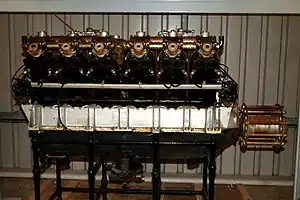Fiat A.14
The Fiat A.14 was an Italian 12-cylinder, liquid-cooled, V aero engine of World War I. The A.14 held the distinction at the end of World War I of being the largest and most powerful aircraft engine in the world. First produced in 1917, 500 were built by the end of the war.
| A.14 | |
|---|---|
 | |
| Preserved Fiat A.14 engine | |
| Type | Piston engine |
| Manufacturer | Fiat |
| First run | 1917 |
| Number built | 500 |
Applications
Specifications (Fiat A.14)
Data from World Encyclopaedia of Aero Engines[1]
General characteristics
- Type: V-12 water-cooled piston engine
- Bore: 170 mm (6.69 in)
- Stroke: 210 mm (8.26 in)
- Displacement: 57.2 L (3,490.5 cu in)
- Length: 2,090 mm (82.28 in)
- Width: 900 mm (35.43 in)
- Height: 990 mm (39 in)
- Dry weight: 800 kg (1,763 lb)
Components
- Fuel system: Carburetor
- Cooling system: water-cooled
Performance
- Power output: 725 hp
References
| Wikimedia Commons has media related to Fiat A.14. |
- Gunston, Bill (1989). World Encyclopaedia of Aero Engines (2nd ed.). Cambridge, England: Patrick Stephens Limited. p. 57. ISBN 978-1-85260-163-8.
- Gunston, Bill (1989). World Encyclopaedia of Aero Engines (2nd ed.). Cambridge, England: Patrick Stephens Limited. ISBN 978-1-85260-163-8.
This article is issued from Wikipedia. The text is licensed under Creative Commons - Attribution - Sharealike. Additional terms may apply for the media files.